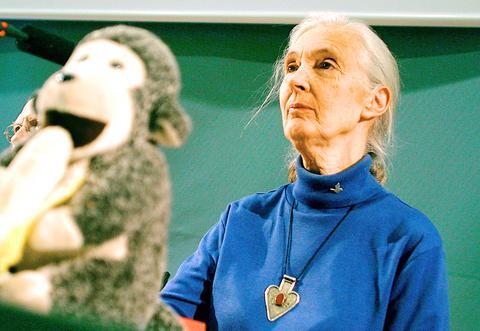You partied on it all summer long, now it's time go clean up the beach. Dr Jane Goodall will be in town tomorrow to help Taiwan clean up the shoreline at Liukuai north of Danshui as part of her Roots and Shoots network of community volunteers.
The Roots and Shoots program began when 16 students gathered with Dr Goodall on her front porch in Tanzania in 1991. The students were fascinated by animal behavior and concerned about the state of the environment. But their schools didn't cover these topics. The students wondered if they could further these interests through out-of-school activities.

PHOTO: AP
Their conversation ranged from how to help chimpanzees to how their actions might affect their communities. The 16 returned to their schools with a task: Find other interested young people and take action. And so the Roots and Shoots program was born.
Roots and Shoots groups undertake "service-learning" projects that promote care and concern for animals, the environment or the community. There are more than 6,000 groups ranging in size from two to 2,000 members registered in more than 87 countries.
Their mission is to foster respect and compassion for all living things, to promote understanding of all cultures and beliefs, and to inspire each individual to take action to make the world a better place for people, animals, and the environment.
And sometimes to clean up a beach. The local chapter of the International Jane Goodall Association will be picking up volunteers at the Hongshulin MRT station bright and early at 8:30am. Organizer Zhu Pei-wen (朱珮文) asked that no one be late, but said the bus may be making a second or third trip, depending on the number of volunteers. She also warned that the coastal winds at Danshui can be fierce and chilly and advised that everyone dress accordingly.
Following the clean-up, Dr. Goodall will give a talk on volunteering for the community at the lecture hall of Zhen Li University (真理大學活動中心演講廳). Box lunches will be made available.
Teachers, if you're interested in incorporating Roots and Shoots community-awareness programs into your class curriculum, there is information available on the Web, including lesson plans for all ages. Check out http://www.rootsandshoots.org/in-schools/default.asp for more information.
Performance notes:
WHAT: Beach Clean-up
WHERE: LiuKuai Beach. Meet for bus pick up at Honshulin MRT Station
WHEN: Tomorrow, Saturday, Dec. 4, at 8:30am. Clean-up will go until 4pm.

On April 26, The Lancet published a letter from two doctors at Taichung-based China Medical University Hospital (CMUH) warning that “Taiwan’s Health Care System is on the Brink of Collapse.” The authors said that “Years of policy inaction and mismanagement of resources have led to the National Health Insurance system operating under unsustainable conditions.” The pushback was immediate. Errors in the paper were quickly identified and publicized, to discredit the authors (the hospital apologized). CNA reported that CMUH said the letter described Taiwan in 2021 as having 62 nurses per 10,000 people, when the correct number was 78 nurses per 10,000

As we live longer, our risk of cognitive impairment is increasing. How can we delay the onset of symptoms? Do we have to give up every indulgence or can small changes make a difference? We asked neurologists for tips on how to keep our brains healthy for life. TAKE CARE OF YOUR HEALTH “All of the sensible things that apply to bodily health apply to brain health,” says Suzanne O’Sullivan, a consultant in neurology at the National Hospital for Neurology and Neurosurgery in London, and the author of The Age of Diagnosis. “When you’re 20, you can get away with absolute

May 5 to May 11 What started out as friction between Taiwanese students at Taichung First High School and a Japanese head cook escalated dramatically over the first two weeks of May 1927. It began on April 30 when the cook’s wife knew that lotus starch used in that night’s dinner had rat feces in it, but failed to inform staff until the meal was already prepared. The students believed that her silence was intentional, and filed a complaint. The school’s Japanese administrators sided with the cook’s family, dismissing the students as troublemakers and clamping down on their freedoms — with

As Donald Trump’s executive order in March led to the shuttering of Voice of America (VOA) — the global broadcaster whose roots date back to the fight against Nazi propaganda — he quickly attracted support from figures not used to aligning themselves with any US administration. Trump had ordered the US Agency for Global Media, the federal agency that funds VOA and other groups promoting independent journalism overseas, to be “eliminated to the maximum extent consistent with applicable law.” The decision suddenly halted programming in 49 languages to more than 425 million people. In Moscow, Margarita Simonyan, the hardline editor-in-chief of the